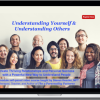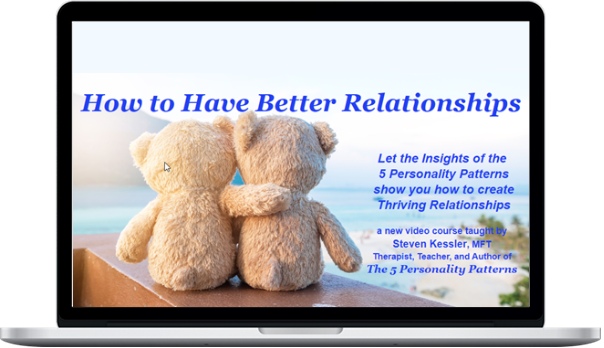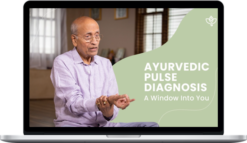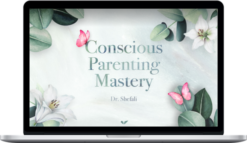Steven Kessler – How to Have Better Relationships
$295.00 $118.00
Total Sold: 1
»Instant Delivery
Description
Steven Kessler – How to Have Better Relationships
Description Of How to Have Better Relationships
You can learn to interact skillfully with anyone.
But first you have to understand them, and then you have to know how to approach them. Of course, you want all your interactions with others to be easy and happy.
But things don’t always go that way. Sometimes what other people do and say is hard to understand. Sometimes it even seems like they’re living in a different world.
Many couples have the same fight over and over. It never ends. It’s confusing. It’s frustrating. They can’t figure out:
- how it started
- what it’s really about
- how to end it
This can happen in any relationship – family, friends, co-workers – even with people you hardly know.
The problem is that the two of you are caught in different personality patterns, which means you’re living in different worlds.
You can’t see the problem, though, because you’ve always seen the world your way. You have now idea how different their world is from yours. And they have no idea how different your world is from theirs.
So you misread each other. Over and over. Cues get missed. Feelings get hurt. And pretty soon you’re having that same old fight – again – and neither of you knows how to stop it.
It isn’t your fault.
It isn’t their fault.
You can’t stop it.
But now you can stop it. You can learn about other people’s worlds. And you can discover how to communicate with them successfully.
The How to Have Better Relationships course will teach you things about other people that even they don’t know. Each module will teach you about the fears and safety strategies that motivate their behavior. Each week you’ll discover new ways to approach and talk to them to get what you want.
And you can immediately apply your new skills everywhere in your life. Suddenly, it will seem like you have x-ray vision. You’ll be able to see what’s going on inside them and what they need to feel safer. You’ll find yourself able to deal with them more successfully. Instead of feeling scared or angry or judgmental, you may even find yourself feeling compassion for them.
Others who took this course have reported that it saved their marriage. Or led to success in their business or profession. Or shifted them from self-judgment to self-love.
You can have those benefits, too. You can learn what’s really happening inside yourself and others. You can learn the skills you need to stop the endless fights and communicate successfully.
It’s not rocket science. It’s just knowledge. But you need to know it. How to Have Better Relationships gives you that knowledge.
What You’ll Learn In How to Have Better Relationships
Here’s What You’ll Learn
During this fun, exciting course, you’ll learn:
- the 5 ways people try to stay safe
- How those 5 safety strategies become Personality Patterns
- How to recognize each Pattern in yourself and others
- How to approach each Pattern
- How to speak so they will listen
- How to listen so they will talk
- How to re-center yourself when things get hard
- How to relate successfully to anyone
- “It’s like having x-ray vision!”
You’ll explore 7 modules:
Module 1: Discerning Patterns
How the 5 Safety Strategies Shape Us
We begin by exploring what different people fear, how they habitually respond to try to feel safer, and how that habitual response shapes their entire experience of the world.
In module 1 you’ll discover:
- the 5 Safety Strategies people use
- how Safety Strategies become Personality Patterns
- that people have both primary and secondary patterns
- how to tell what Pattern a person is caught in now
- a 5 second re-centering practice
Module 2: The Leaving Pattern
“Gotta get away.”
The safety strategy here is to flee, both energetically and physically. The pattern is head-centered and tries to avoid conflict by abandoning the body. But abandoning the body weakens it and makes the physical world seem even scarier.
In module 2 you’ll discover:
- what makes the physical world seem so scary to them
- why they use leaving to protect themselves
- how to focus on energy, like they do
- how to approach them in ways they like
- how to stay centered in their presence
Module 3: The Merging Pattern
“It’s all about Love.”
The safety strategy here is to connect with others, to please and appease and get them to like you. The pattern is heart-centered and wants a heart to heart connection to feel safer.
In module 3 you’ll discover:
- how they use connecting to protect themselves
- why they talk so much
- how to give them a heart to heart connection
- how to approach them in ways they like
- how to stay centered in their presence
Module 4: The Enduring Pattern
“It’s all about space.”
Their early injury was being invaded and over-controlled, so to feel safer now, they want lots of space around them, without you probing or messing with them. The pattern is belly-centered and tries to protect itself by avoiding interactions.
In module 4 you’ll discover:
- why people who do this pattern want so much space
- why they talk so little
- how to honor their space so they will come out more
- how to approach them in ways they like
- how to stay centered in their presence
Module 5: The Aggressive Pattern
“It’s all about power.”
The injury here was to their trust in others, so their safety strategy is to dominate others and command help rather than take the risk of asking for it. The pattern is belly-centered and wants to avoid needs, weakness, and dependency.
In module 5 you’ll discover:
- why they are so focused on power and dominance
- how to protect yourself
- how to speak from your core so they will trust you
- how to approach them in ways they like
- how to stay centered in their presence
Module 6: The Rigid Pattern
“It’s all about doing it right.”
The injury here was to their self trust, so their safety strategy is to rely on outside rules and forms for guidance, instead of on their own inner knowing. The pattern is head-centered and tends to ignore personal wants and needs and focus instead on correctness and performance.
In module 6 you’ll discover:
- why they get stuck in black and white, right-wrong thinking
- how to manage their Inner Critic so they can hear you
- how to respect their Rules so they will listen to you
- how to approach them in ways they like
- how to stay centered in their presence
Module 7: The Patterns in Romance
How the Patterns Interact in Relationships
Now we bring it all together to understand how the personality patterns interact in romantic relationships.
In module 7 you’ll discover:
- how similar patterns interact in romantic relationships
- how different patterns interact in romantic relationships
- 6 different ways to get yourself out of a pattern and back to presence
- how to continually re-center yourself
About Steven Kessler
Embark on a Life-changing Journey with a Master Guide
Steven Kessler, MFT has been studying people his whole life. For almost 40 years, he’s been a licensed psychotherapist, studying many different healing modalities and maps of personality, including Character Structure, the Enneagram, NLP, energy work, Thought Field Therapy, and EFT (Emotional Freedom Techniques), as well as spending 16 years in the Diamond Heart meditation school.
Since 1984, Steven has taught hundreds of groups and workshops in the U.S. and internationally, helping men and women heal their wounds and grow into their full adult selves. For over 15 years, he has been a student of Lynda Caesara, studying Character Structure, the direct perception of energy, and shamanism in the lineage of Grandfather Two Bears and the Southern Seers tradition.
His bestselling book, The 5 Personality Patterns, lays out a simple, clear, true-to-life map of personality that gives you the key to understanding people and relating to them effectively. Stephen M. Johnson, one of the most famous authors in the field, called it “one of the most useful popular psychology books I have ever seen.” Readers email him frequently with stories of how reading it has changed their lives.
When you say “YES” to this healing journey, you’ll discover:
- How to recognize the Patterns in yourself and others
- How to approach each Pattern
- How to speak so they will listen
- How to listen so they will talk
- How to continually re-center yourself
- How to relate successfully to anyone
More courses from the same author: Steven Kessler
Delivery Policy
When will I receive my course?
You will receive a link to download your course immediately or within 1 to 21 days. It depends on the product you buy, so please read the short description of the product carefully before making a purchase.
How is my course delivered?
We share courses through Google Drive, so once your order is complete, you'll receive an invitation to view the course in your email.
To avoid any delay in delivery, please provide a Google mail and enter your email address correctly in the Checkout Page.
In case you submit a wrong email address, please contact us to resend the course to the correct email.
How do I check status of my order?
Please log in to HealingCourse account then go to Order Page. You will find all your orders includes number, date, status and total price.
If the status is Processing: Your course is being uploaded. Please be patient and wait for us to complete your order. If your order has multiple courses and one of them has not been updated with the download link, the status of the order is also Processing.
If the status is Completed: Your course is ready for immediate download. Click "VIEW" to view details and download the course.
Where can I find my course?
Once your order is complete, a link to download the course will automatically be sent to your email.
You can also get the download link by logging into your HealingCourse account then going to Downloads Page.
Related products
Total sold: 16
Total sold: 1








